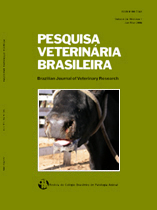 |
|
|
|
Year 2007 - Volume 27, Number 07
|

|
Análise filogenética do papilomavírus bovino associado a lesões cutâneas em rebanhos do Estado do Paraná, p.314-318
|
ABSTRACT.- Claus M.P., Vivian D., Lunardi M., Alfieri A.F. & Alfieri A.A. 2007. [Phylogenetic analysis of bovine papillomavirus associated with skin warts in cattle herds from the state of Paraná.] Análise filogenética do papilomavírus bovino associado a lesões cutâneas em rebanhos do Estado do Paraná. Pesquisa Veterinária Brasileira 27(7):314-318. Laboratório de Virologia Animal, Departamento de Medicina Veterinária Preventiva, Centro de Ciências Agrárias, Universidade Estadual de Londrina, Cx. Postal 6001, Campus Universitário, Londrina, PR 86051-990, Brazil. E-mail: alfieri@uel.br
Bovine papillomavirus (BPV) infection causes hyperplastic lesions in the cutaneous epithelium of cattle. Six types of BPV were classified in two sub-groups, being correlated to the anatomical regions of the infection and morphologic characteristics of the lesions. The present study was carried out to identify the types of BPV present in skin warts of cattle from the state of Paraná, Brazil. The generic primers FAP59 and FAP64 were used for amplification of a 478 bp fragment of BPV L1 gene in nine cutaneous papilloma samples obtained from six animals in four herds. In all papillomas examined, a product with the expected molecular size was amplified. Phylogenetic analysis of the PCR products identified BPV-2 in three samples, BPV-1 in one, and BPV-6 in five papillomas. BPV-6 was detected in cutaneous papillomas of the teat and in other body parts as well. In one animal, from which more than one sample was collected, a concomitant infection by BPV-1 and BPV-2 was identified. The five positive BPV-6 samples showed a nucleotide identity of 100% with the sequence of the reference strain available in GenBank. However, differences among BPV-2 and BPV-1 Brazilian samples and the respective reference sequences deposited in GenBank were observed. Molecular comparison of the two BPV-2 strains identified showed the involvement of two viral variants. This study revealed the diversity of BPV types circulating in the state of Paraná. |
| |
|
|
| |
|
 |